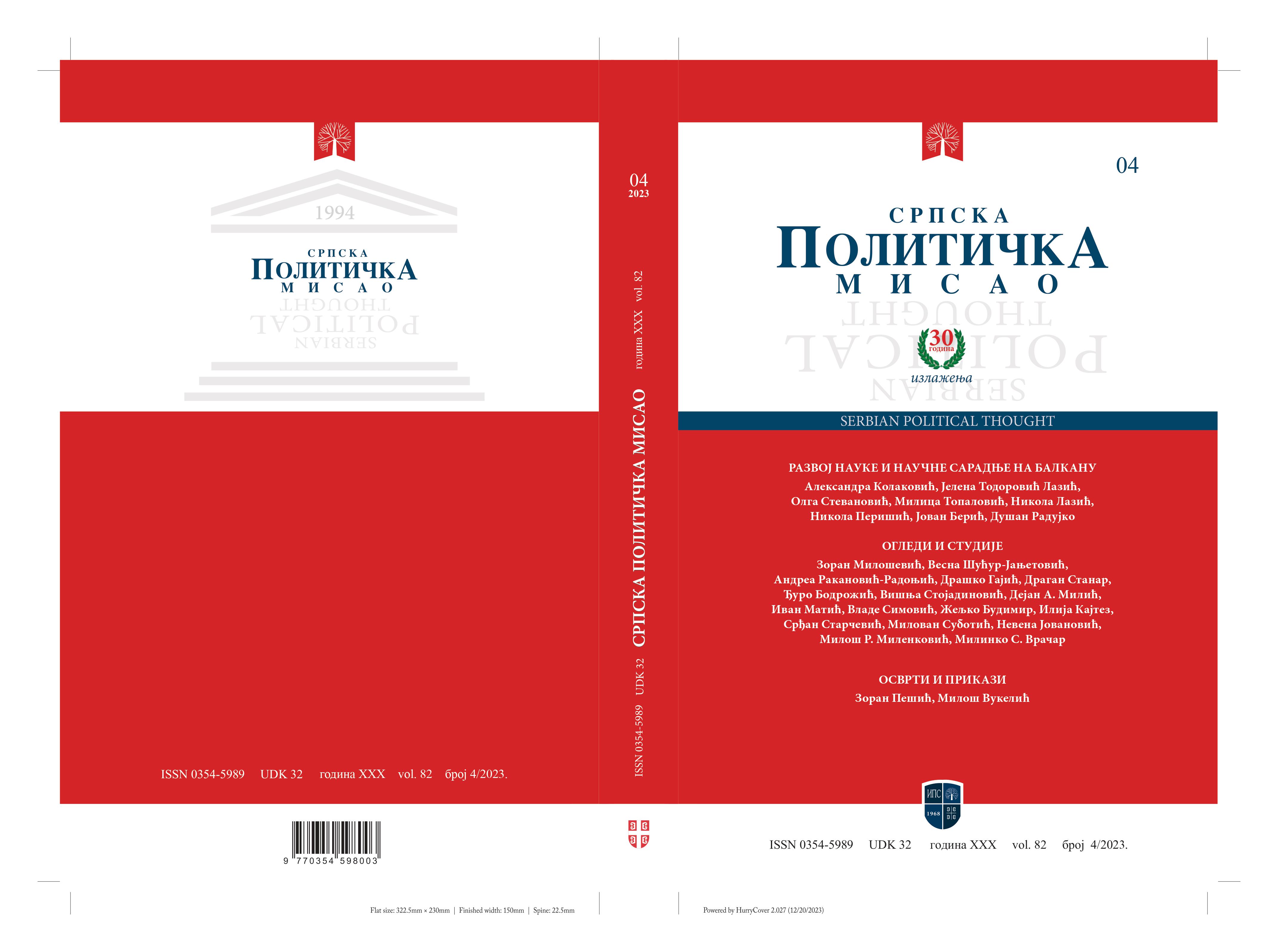РОДНА РАВНОПРАВНОСТ У ОБЛАСТИ ИСТРАЖИВАЊА И ИНОВАЦИЈА – ЕУ НАСУПРОТ СРБИЈЕ, СЕВЕРНЕ МАКЕДОНИЈЕ И ЦРНЕ ГОРЕ
Sažetak
Током последњих деценија, ЕУ се посебно фокусирала на успостављање једнаких могућности и једнаког третмана жена и мушкараца у свим сферама живота. Томе су нарочито допринеле регулаторне мере које је Унија постепено увела у области родне равноправности као што су: мере које обезбеђују једнаку плату, заштиту материнства, прописи о родитељском одсуству. Публикација She Figures коју објављује Европска комисија на сваке три године, користи најновију доступну статистику за праћење стања родне равноправности у домену истраживања и иновација и тако нам пружа могућност да упоредо пратимо податке и анализе за 88 индикатора широм Европе. То је уједно и предмет овог рада. Један од циљевa је да се утврди колико је политика родне равноправности у области истраживања и иновација интегрисана код придружених држава: Србије, Северне Македоније и Црне Горе, односно, колико се подаци који се односе на ове три државе поклапају или одступају од просека на нивоу ЕУ на основу података које нам даје поменута публикација, у издању за 2021. годину.
Reference
Arribas, Gracia Vara and Carrasco, Laura. 2003.”Gender equality and the EU – An assessment of the current issues.” Eipascope, 1: 1–9.
Avdeyeva, Olga. 2010. “State´s Compliance with International Requirements. Gender Equality in EU Enlargement Countries.” Political Research Quarterly, 62 (1): 203-217.
Costello, Cathryn. 2003. Gender equalities and the European Union Charter of Fundamental Rights, Economic and Social Rights under the Charter of Fundamental Rights of the European Union. Hart Publishing, pp. 111–138.
Consolidated version of the Treaty on European Union, https://eur-lex.europa.eu/resource.html?uri=cellar:2bf140bf-a3f8-4ab2-b506-fd71826e6da6.0023.02/DOC_1&format=PDF
Consolidated version of the Тreaty on the functioning of the Еuropean Union, https://eur-lex.europa.eu/LexUriServ/LexUriServ.do?uri=CELEX:12012E/TXT:en:PDF
https://www.consilium.europa.eu/en/press/press-releases/2023/04/24/gender-pay-gap-council-adopts-new-rules-on-pay-transparency/
Council conclusions. 2015. On advancing gender equality in the European Research Area, https://data.consilium.europa.eu/doc/document/ST-14846-2015-INIT/en/pdf
Council of Europe. 1998. Gender Mainstreaming – Conceptual framework, methodology and presentation of good practices – Final report of activities of the Group of Specialists on Mainstreaming, Strasbourg, https://www.unhcr.org/3c160b06a.pdf
Council of the European Union, Directive 75/117/EEC of 10 February 1975 on the approximation of the laws of the Member States relating to the application of the principle of equal pay for men and women, Official Journal of the European Union, L 45, Publications Office of the European Union, https://eur-lex.europa.eu/legal-content/ en/ALL/?uri=CELEX %3A31975L0117.
Defeis, Elizabeth. 1999. “The Treaty of Amsterdam: The next step towards gender equality?.” Boston College International and Comparative Law review, 23 (1): 1–33.
European Commission. 2010a. A strengthened commitment to equality between women and men: A women’s charter, COM(2010) 78
European Commission. 2010b. Strategy for equality between women and men 2010–2015, COM(2010) 491
European Comission, Directorate-General for Justice and Consumers. 2016. Strategic engagement for gender equality 2016-2019, European Commission, Publications Office, https://data.europa.eu/doi/10.2838/454429
European Commission. 2020a. A Union of equality: Gender equality strategy 2020–2025, COM(2020) 152 https://eurlex.europa.eu/legalcontent/EN/TXT/?uri=CELEX%3A52020DC0152&qid=1630498219130
European Commission. 2020b. A new ERA for Research and Innovation {SWD(2020) 214 final
European Commission. 2020c. Digital Education Action Plan 2021-2027. https://eur-lex.europa.eu/legal-content/EN/TXT/?uri=CELEX%3A52020DC0624
European Commission. 2020d. Women in Digital. https://digital-strategy.ec.europa.eu/en/library/women-digital
European Commission, Directorate-General for Research and Innovation. 2021. Horizon Europe, gender equality – A strengthened commitment in Horizon Europe, Publications Office, https://data.europa.eu/doi/10.2777/97891.
European Commission, Directorate-General for Justice and Consumers. 2022a. 2022 report on gender equality in the EU, Publications Office https://data.europa.eu/doi/10.2838/94579
European Commission. 2022b. Communication from the Commission to The European Parliament, The Council, The European Economic and Social Committee and the Committee of the Regions on achieving the European Education Area, COM(2022) 700 final
Hoskyns, Catherine. 1996. Integrating Gender – Women, law and politics in the European Union, London: Verso.
Jacquot, Sophie. 2014. L’égalité au nom du marché? Émergence et démantèlement de la politique européenne d’égalité entre les hommes et les femmes, Brussels: Peter Lang.
Joint communication to the European Parliament and the Council. 2020. EU gender action plan (gap) III – an ambitious agenda for gender equality and women’s empowerment in EU external action {SWD(2020) 284 final
Paraskevi Naskou-Perraki.2007. EU Gender Equality Law, Athens: Papazissis Publishers.
She Figures - Gender in Research and Innovation Statistics and Indicators, 2021.
Von der Leyen, Ursula. 2020. Political Guidelines for the Next European Commission 2019-2024 – Opening statement in the European Parliament plenary session 16 July 2019; Speech in the European Parliament plenary session 27 November 2019, Publications Office of the European Union, https://data.europa.eu/doi/10.2775/101756
Werner, Sandra. 2010. “EU Gender Equality Principles in EU Accession A case study of the current EU candidate countries Turkey and Croatia.“ http://essay.utwente.nl/60315/

